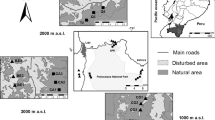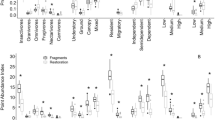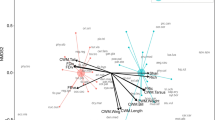Abstract
Disturbed forests are increasingly common in tropical regions. Although the conservation value of these habitats has been highlighted, few studies have considered their potential in retaining biodiversity and ecosystem services. Therefore, in this study, we address how different levels of disturbance in Araucaria forests affect bird functional diversity. We used Rapid Ecological Assessment as a method to determine a disturbance gradient in Araucaria forest sites and evaluated how biotic integrity of vegetation was associated with alpha functional diversity (functional richness and functional dispersion). We recorded a total of 112 bird species in the eight Araucaria forest sites. Biotic integrity of vegetation ranged from 33.3 to 51.3. No association was found between functional richness and biotic integrity of vegetation. However, we found a negative association between biotic integrity of vegetation and functional dispersion, which indicates that bird communities in less disturbed forests sites are more functionally redundant than those communities in highly disturbed habitats. Overall, the studied disturbed Araucaria forest sites have great biodiversity value and should be considered in conservation strategies to guarantee bird taxonomic and functional diversity.


Similar content being viewed by others
References
Anjos L, Volpato GH, Mendonça LB et al (2010) Técnicas de levantamento quantitativo de aves em ambiente florestal: uma análise comparativa baseada em dados empíricos. In: Matter SV, Straube FC, Accordi IA, Piacentini VQ (eds) Ornitologia e Conservação. Technical Books, Rio de Janeiro, pp 63–76
Barlow J, Lennox GD, Ferreira J et al (2016) Anthropogenic disturbance in tropical forests can double biodiversity loss from deforestation. Nature 535:144–147. https://doi.org/10.1038/nature18326
Bibby CJ, Burgess ND, Hill DA, Mustoe S (2000) Bird Census Techniques. Academic Press, London
Biggs CR, Yeager LA, Bolser DG et al (2020) Does functional redundancy affect ecological stability and resilience? A review and meta-analysis. Ecosphere 11:e03184. https://doi.org/10.1002/ecs2.3184
Bonfim FCG, Dodonov P, Cazetta E (2021) Landscape composition is the major driver of the taxonomic and functional diversity of tropical frugivorous birds. Landsc Ecol 36:2535–2547. https://doi.org/10.1007/s10980-021-01266-y
Castella PR, Britez RM (2004) A floresta com araucária no Paraná: conservação e diagnóstico dos remanescentes florestais. Fundação de Pesquisas Florestais do Paraná. Ministério do Meio Ambiente, Brasília
Cribari-Neto F, Zeileis A (2009) Beta regression in R. University of Economics and Business, Vienna
De Bello F, Thullier W, Lepš J et al (2009) Partitioning of functional diversity reveals the scale and extent of trait convergence and divergence. J Veg Sci 20:475–486. https://doi.org/10.1111/j.1654-1103.2009.01042.x
De Coster G, Banks-Leite C, Metzger JP (2015) Atlantic forest bird communities provide different but not fewer functions after habitat loss. Proc Royal Soc B 282:20142844. https://doi.org/10.1098/rspb.2014.2844
Del Hoyo J, Elliott A, Sargatal J, Christie DA, de Juana E (2015) Handbook of the birds of the world alive. Lynx Edicions, Barcelona. http://www.hbw.com/. Accessed 10 October 2015
Dunning JR (1992) CRC handbook of avian body masses. CRC press, New York
Edwards DP, Tobias JA, Sheil D et al (2014) Maintaining ecosystem function and services in logged tropical forests. Trends Ecol Evol 29:511–520. https://doi.org/10.1016/j.tree.2014.07.003
FAO, Food and Agriculture Organization (2015) Global forest resources assessment - how are the world’s forests changing? Food and Agriculture Organization of the United Nations, Rome. http://www.fao.org/3/a-i4793e.pdf. Accessed 02 October 2017
Farah FT, de Lara MR, Ribeiro MC et al (2017) Integrating plant richness in forest patches can rescue overall biodiversity in human-modified landscapes. For Ecol Manag 397:78–88. https://doi.org/10.1016/j.foreco.2017.03.038
Ferrari SLP, Cribari-Neto F (2004) Beta regression for modelling rates and proportions. J Appl Stat 31:799–815. https://doi.org/10.1080/0266476042000214501
Fontúrbel FE, Betancurt-Grisales JF, Vargas-Daza AM et al (2022) Effects of habitat degradation on bird functional diversity: a field test in the Valdivian rainforest. For Ecol Manag 522:120466. https://doi.org/10.1016/j.foreco.2022.120466
Gagic V, Bartomeus I, Jonsson T et al (2015) Functional identity and diversity of animals predict ecosystem functioning better than species-based indices. Proc R Soc B: Biol Sci 28:20142620. https://doi.org/10.1098/rspb.2014.2620
Gibson L, Lee TM, Koh LP et al (2011) Primary forests are irreplaceable for sustaining tropical biodiversity. Nature 478:378–381. https://doi.org/10.1038/nature10425
Hidasi-Neto J, Barlow J, Cianciaruso MV (2012) Bird functional diversity and wildfires in the Amazon: the role of forest structure. Anim Conserv 15:407–415. https://doi.org/10.1111/j.1469-1795.2012.00528.x
Jones HH, Barreto E, Murillo O et al (2021) Turnover-driven loss of forest-dependent species changes avian species richness, functional diversity, and community composition in Andean Forest fragments. Glob Ecol Conserv 32:e01922. https://doi.org/10.1016/j.gecco.2021.e01922
Kieschnick R, Mccullough BD (2003) Regression analysis of variates observed on (0, 1): percentages proportions and fractions. Stat Modelling 3:193–213. https://doi.org/10.1191/1471082X03st053oa
Laliberté E, Legendre P, Shipley B, Laliberté ME (2014) Measuring functional diversity from multiple traits, and other tools for functional ecology. R Package FD
Laurance WF, Sayer J, Cassman KG (2014) Agricultural expansion and its impacts on tropical nature. Trends Ecol Evol 29:107–116. https://doi.org/10.1016/j.tree.2013.12.001
Liebsch D, Reginato M (2009) Florescimento e frutificação de Merostachys skvortzovii Sendulsky (taquara-lixa) no estado do Paraná. Iheringia 64:53–56
Luck GW, Lavorel S, McIntyre S, Lumb K (2012) Improving the application of vertebrate trait-based frameworks to the study of ecosystem services. J Anim Ecol 81:1065–1076. https://doi.org/10.1111/j.1365-2656.2012.01974.x
Matuoka MA, Benchimol M, de Almeida-Rocha JM et al (2020) Effects of anthropogenic disturbances on bird functional diversity: a global meta-analysis. Ecol Indic 116:106471. https://doi.org/10.1007/s10531-015-0953-1
Mayfield MM, Bonser SP, Morgan JW et al (2010) What does species richness tell us about functional trait diversity? Predictions and evidence for responses of species and functional trait diversity to land-use change. Glob Ecol Biogeogr 19:423–431. https://doi.org/10.1111/j.1466-8238.2010.00532.x
Medeiros HR, Torezan JM (2013) Evaluating the ecological integrity of Atlantic forest remnants by using rapid ecological assessment. Environ Monit Assess 185:4373–4382. https://doi.org/10.1007/s10661-012-2875-7
Mori AS, Furukawa T, Sasaki T (2013) Response diversity determines the resilience of ecosystems to environmental change. Biol Rev 88:349–364. https://doi.org/10.1111/brv.12004
Mouchet MA, Villéger S, Mason NW, Mouillot D (2010) Functional diversity measures: an overview of their redundancy and their ability to discriminate community assembly rules. Funct Ecol 4:867–876. https://doi.org/10.1111/j.1365-2435.2010.01695.x
Mouillot D, Graham NAJ, Villéger S et al (2013) A functional approach reveals community responses to disturbances. Trends Ecol Evol 28:167–177. https://doi.org/10.1016/j.tree.2012.10.004
Patten MA, Patten-Smith BD (2012) Testing the microclimate hypothesis: light environment and population trends of Neotropical birds. Biol Conserv 155:85–93. https://doi.org/10.1016/j.biocon.2012.06.004
Pavoine S, Love M, Bonsall M (2009) Hierarchical partitioning of evolutionary and ecological patterns in the organization of phylogenetically-structured species assemblages: application to rockfish (genus: Sebastes) in the Southern California bight. Ecol Lett 12:898–908. https://doi.org/10.1016/j.ecolind.2017.06.056
Polisel RT, Ivanauskas NM, Assis MCD et al (2014) Structure of the understory community in four stretches of Araucaria forest in the state of São Paulo, Brazil. Acta Bot Bras 28:86–101. https://doi.org/10.1590/S0102-33062014000100009
Pollock HS, Cheviron ZA, Agin TJ et al (2015) Absence of microclimate selectivity in insectivorous birds of the Neotropical forest understory. Biol Conserv 188:116–125. https://doi.org/10.1016/j.biocon.2014.11.013
Powell LL, Cordeiro NJ, Stratford JA (2015) Ecology and conservation of avian insectivores of the rainforest understory: a pantropical perspective. Biol Conserv 188:1–10
R Core Team (2016) R: A language and environment for statistical computing. R Foundation for Statistical Computing, Vienna, Austria. http://www.r-project.org/.
Ricotta C, de Bello F, Moretti M et al (2016) Measuring the functional redundancy of biological communities: a quantitative guide. Methods Ecol Evol 7:1386–1395. https://doi.org/10.1111/2041-210X.12604
Sayer CA, Bullock JM, Martin PA (2017) Dynamics of avian species and functional diversity in secondary tropical forests. Biol Conserv 211:1–9. https://doi.org/10.1016/j.biocon.2017.05.004
Sayre R, Roca E, Sedaghatkish G, Young B, Keel S, Roca R (2000) Nature in focus: rapid ecological assessment. Island Press, Washington D.C.
Sekercioglu ÇH, Wenny DG, Whelan CJ (2016) Why birds matter: avian ecological function and ecosystem services. University of Chicago Press, Chicago
Si X, Baselga A, Leprieur F et al (2016) Selective extinction drives taxonomic and functional alpha and beta diversities in island bird assemblages. J Anim Ecol 153:153–161. https://doi.org/10.1111/j.1461-0248.2010.01493.x
Stuart-Smith RD, Bates AE, Lefcheck JS et al (2016) Integrating abundance and functional traits reveals new global hotspots of fish diversity. Nature 501:539. https://doi.org/10.1038/nature12529
Vielliard JEM, Silva WR (1990) Nova metodologia de levantamento quantitativo da avifauna e primeiros resultados no interior do Estado de São Paulo, Brasil. 4 Encontro Nacional dos Anilhadores de Aves, Recife, PE, Brazil, pp 117–151
Vielliard JME, Almeida MEC, Anjos L, Silva WR (2010) Levantamento quantitativo por pontos de escuta e o Índice Pontual de Abundância (IPA). In: Straube FC, Accordi I, Piacentini V, Cândido-Jr JF (eds) Von Matter S. Ornitologia e Conservação. Technical Books, Rio de Janeiro, pp 47–60
Villéger S, Grenouillet G, Brosse S (2013) Decomposing functional β-diversity reveals that low functional β-diversity is driven by low functional turnover in European fish assemblages. Glob Ecol Biogeogr 22:671–681. https://doi.org/10.1111/geb.12021
Villéger S, Mason NWH, Mouillot D (2008) New multidimensional functional diversity indices for a multifaceted framework in functional ecology. Ecology 89:2290–2301. https://doi.org/10.1890/07-1206.1
Wilman H, Belmaker J, Simpson J et al (2014) Elton Traits 1.0: species-level foraging attributes of the world’s birds and mammals. Ecology 95:2027–2027. https://doi.org/10.1890/13-1917.1
Zuur AF, Ieno EN, Meesters EHWG (2009) A beginner’s guide to R. Springer, New York
Acknowledgements
We would like to thank IAP (474.13 2013) and ICMBio (37629-1 2012) and all the private land owners for the research permits. Also, we thank B. de A. Almeida for analytical suggestions.
Funding
This study was supported by Fundação Grupo Boticário (FB: A0003_2012). The grant consisted in financial support for field expenses and equipment to be used in the field. We were also supported by Conselho Nacional de Desenvolvimento Científico e Tecnológico that provided a fellowship to LA (CNPq: 308523/2021-0). Coordenação de Aperfeiçoamento de Pessoal de Nível Superior (CAPES – Finance code 001) also provided fellowships to LCC, HRM for the development of their masters, and to GMB for her Ph.D.
Author information
Authors and Affiliations
Corresponding author
Ethics declarations
Conflict of interest
The authors declare no competing interests.
Additional information
Communicated by José Carlos Morante-Filho (invited Associate Editor)
Supplementary information
ESM 1
(DOCX 30441 kb)
Rights and permissions
Springer Nature or its licensor (e.g. a society or other partner) holds exclusive rights to this article under a publishing agreement with the author(s) or other rightsholder(s); author self-archiving of the accepted manuscript version of this article is solely governed by the terms of such publishing agreement and applicable law.
About this article
Cite this article
Calsavara, L.C., Lima, M.R., Bochio, G.M. et al. Bird communities are more functionally redundant in less disturbed Araucaria forest. Ornithol. Res. 32, 70–77 (2024). https://doi.org/10.1007/s43388-023-00142-4
Received:
Revised:
Accepted:
Published:
Issue Date:
DOI: https://doi.org/10.1007/s43388-023-00142-4




